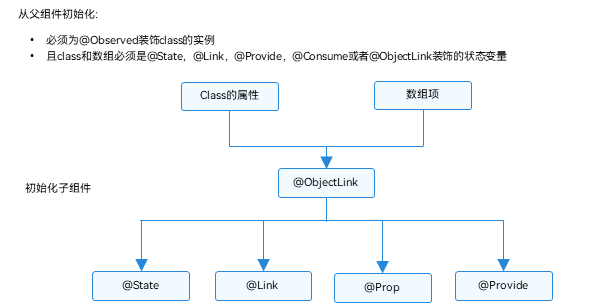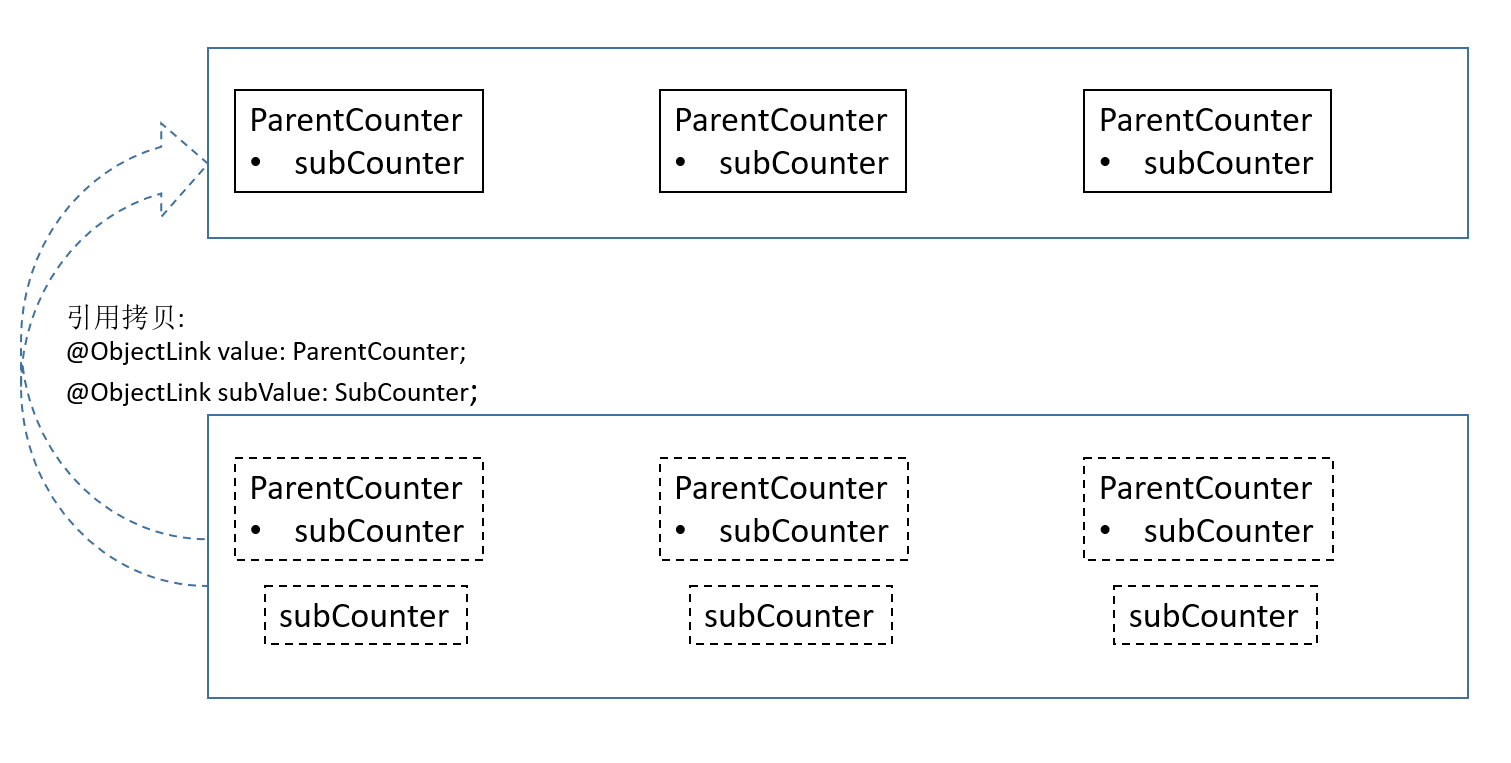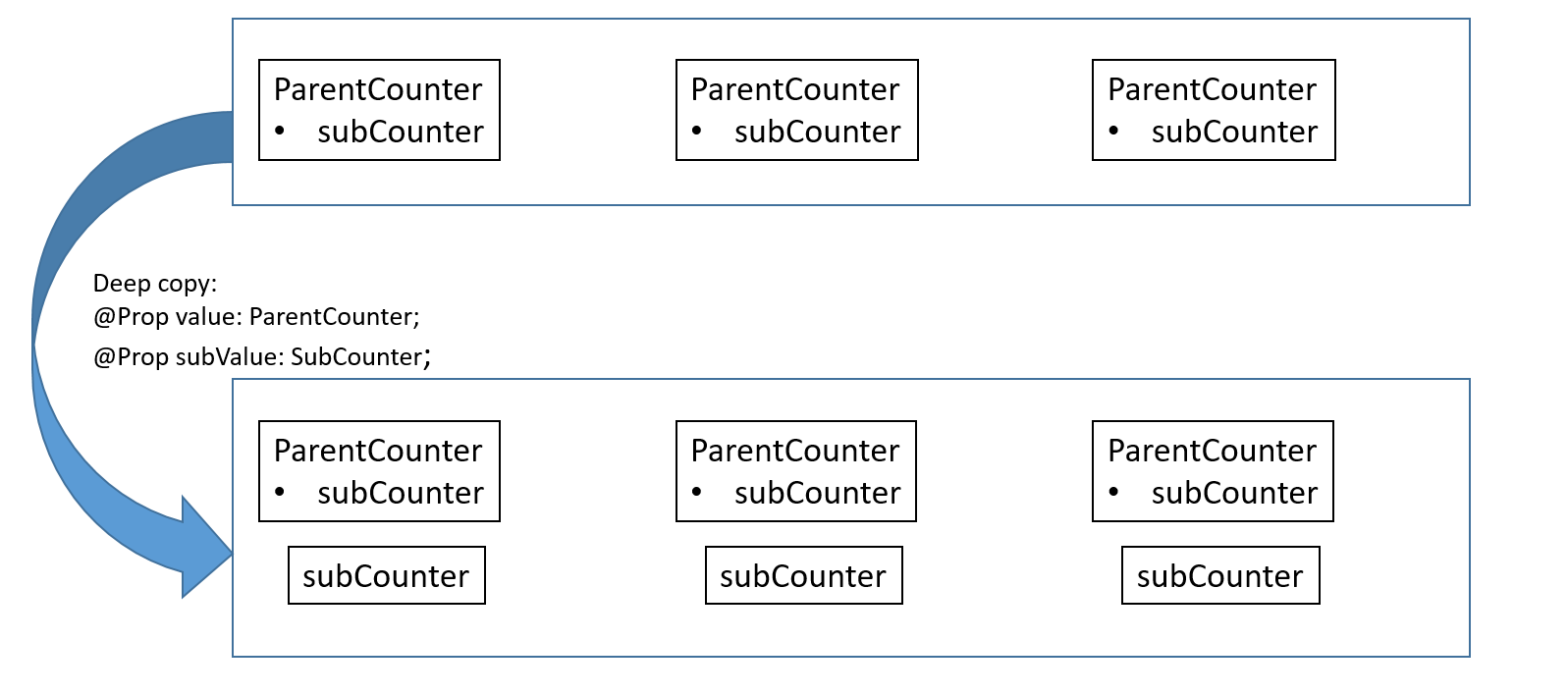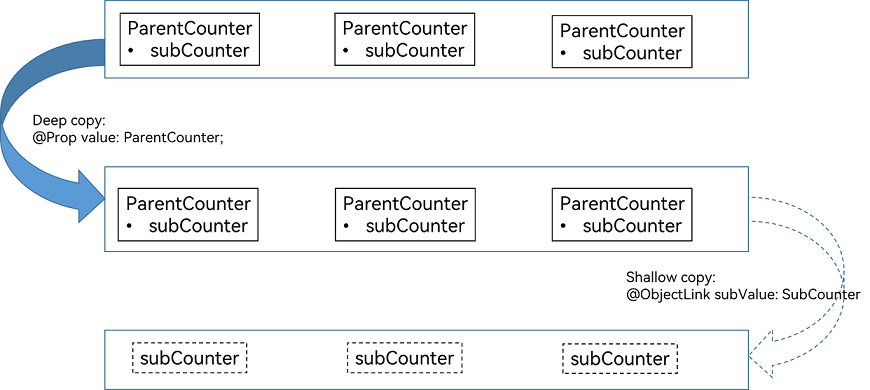harmony 鸿蒙\@Observed装饰器和\@ObjectLink装饰器:嵌套类对象属性变化
\@Observed装饰器和\@ObjectLink装饰器:嵌套类对象属性变化
上文所述的装饰器仅能观察到第一层的变化,但是在实际应用开发中,应用会根据开发需要,封装自己的数据模型。对于多层嵌套的情况,比如二维数组,或者数组项class,或者class的属性是class,他们的第二层的属性变化是无法观察到的。这就引出了\@Observed/\@ObjectLink装饰器。
说明:
从API version 9开始,这两个装饰器支持在ArkTS卡片中使用。
概述
\@ObjectLink和\@Observed类装饰器用于在涉及嵌套对象或数组的场景中进行双向数据同步:
被\@Observed装饰的类,可以被观察到属性的变化;
子组件中\@ObjectLink装饰器装饰的状态变量用于接收\@Observed装饰的类的实例,和父组件中对应的状态变量建立双向数据绑定。这个实例可以是数组中的被\@Observed装饰的项,或者是class object中的属性,这个属性同样也需要被\@Observed装饰。
单独使用\@Observed是没有任何作用的,需要搭配\@ObjectLink或者\@Prop使用。
限制条件
使用\@Observed装饰class会改变class原始的原型链,\@Observed和其他类装饰器装饰同一个class可能会带来问题。
装饰器说明
| \@Observed类装饰器 | 说明 |
|---|---|
| 装饰器参数 | 无 |
| 类装饰器 | 装饰class。需要放在class的定义前,使用new创建类对象。 |
| \@ObjectLink变量装饰器 | 说明 |
|---|---|
| 装饰器参数 | 无 |
| 同步类型 | 不与父组件中的任何类型同步变量。 |
| 允许装饰的变量类型 | 必须为被\@Observed装饰的class实例,必须指定类型。 不支持简单类型,可以使用\@Prop。 支持继承Date或者Array的class实例,示例见观察变化。 支持\@Observed装饰类和undefined或null组成的联合类型,比如ClassA |ClassB, ClassA |undefined 或者 ClassA |null, 示例见@ObjectLink支持联合类型。 \@ObjectLink的属性是可以改变的,但是变量的分配是不允许的,也就是说这个装饰器装饰变量是只读的,不能被改变。 |
| 被装饰变量的初始值 | 不允许。 |
\@ObjectLink装饰的数据为可读示例。
// 允许@ObjectLink装饰的数据属性赋值
this.objLink.a= ...
// 不允许@ObjectLink装饰的数据自身赋值
this.objLink= ...
说明:
\@ObjectLink装饰的变量不能被赋值,如果要使用赋值操作,请使用@Prop。
\@Prop装饰的变量和数据源的关系是是单向同步,\@Prop装饰的变量在本地拷贝了数据源,所以它允许本地更改,如果父组件中的数据源有更新,\@Prop装饰的变量本地的修改将被覆盖;
\@ObjectLink装饰的变量和数据源的关系是双向同步,\@ObjectLink装饰的变量相当于指向数据源的指针。禁止对\@ObjectLink装饰的变量赋值,如果一旦发生\@ObjectLink装饰的变量的赋值,则同步链将被打断。因为\@ObjectLink修饰的变量通过数据源(Object)引用来初始化。对于实现双向数据同步的@ObjectLink,赋值相当于更新父组件中的数组项或者class的属性,TypeScript/JavaScript不能实现,会发生运行时报错。
变量的传递/访问规则说明
| \@ObjectLink传递/访问 | 说明 |
|---|---|
| 从父组件初始化 | 必须指定。 初始化\@ObjectLink装饰的变量必须同时满足以下场景: - 类型必须是\@Observed装饰的class。 - 初始化的数值需要是数组项,或者class的属性。 - 同步源的class或者数组必须是\@State,\@Link,\@Provide,\@Consume或者\@ObjectLink装饰的数据。 同步源是数组项的示例请参考对象数组。初始化的class的示例请参考嵌套对象。 |
| 与源对象同步 | 双向。 |
| 可以初始化子组件 | 允许,可用于初始化常规变量、\@State、\@Link、\@Prop、\@Provide |
图1 初始化规则图示

观察变化和行为表现
观察变化
\@Observed装饰的类,如果其属性为非简单类型,比如class、Object或者数组,也需要被\@Observed装饰,否则将观察不到其属性的变化。
class ClassA {
public c: number;
constructor(c: number) {
this.c = c;
}
}
@Observed
class ClassB {
public a: ClassA;
public b: number;
constructor(a: ClassA, b: number) {
this.a = a;
this.b = b;
}
}
以上示例中,ClassB被\@Observed装饰,其成员变量的赋值的变化是可以被观察到的,但对于ClassA,没有被\@Observed装饰,其属性的修改不能被观察到。
@ObjectLink b: ClassB
// 赋值变化可以被观察到
this.b.a = new ClassA(5)
this.b.b = 5
// ClassA没有被@Observed装饰,其属性的变化观察不到
this.b.a.c = 5
\@ObjectLink:\@ObjectLink只能接收被\@Observed装饰class的实例,可以观察到:
其属性的数值的变化,其中属性是指Object.keys(observedObject)返回的所有属性,示例请参考嵌套对象。
如果数据源是数组,则可以观察到数组item的替换,如果数据源是class,可观察到class的属性的变化,示例请参考对象数组。
继承Date的class时,可以观察到Date整体的赋值,同时可通过调用Date的接口setFullYear, setMonth, setDate, setHours, setMinutes, setSeconds, setMilliseconds, setTime, setUTCFullYear, setUTCMonth, setUTCDate, setUTCHours, setUTCMinutes, setUTCSeconds, setUTCMilliseconds 更新Date的属性。
@Observed
class DateClass extends Date {
constructor(args: number|string) {
super(args)
}
}
@Observed
class ClassB {
public a: DateClass;
constructor(a: DateClass) {
this.a = a;
}
}
@Component
struct ViewA {
label: string = 'date';
@ObjectLink a: DateClass;
build() {
Column() {
Button(`child increase the day by 1`)
.onClick(() => {
this.a.setDate(this.a.getDate() + 1);
})
DatePicker({
start: new Date('1970-1-1'),
end: new Date('2100-1-1'),
selected: this.a
})
}
}
}
@Entry
@Component
struct ViewB {
@State b: ClassB = new ClassB(new DateClass('2023-1-1'));
build() {
Column() {
ViewA({ label: 'date', a: this.b.a })
Button(`parent update the new date`)
.onClick(() => {
this.b.a = new DateClass('2023-07-07');
})
Button(`ViewB: this.b = new ClassB(new DateClass('2023-08-20'))`)
.onClick(() => {
this.b = new ClassB(new DateClass('2023-08-20'));
})
}
}
}
框架行为
初始渲染:
- \@Observed装饰的class的实例会被不透明的代理对象包装,代理了class上的属性的setter和getter方法
- 子组件中\@ObjectLink装饰的从父组件初始化,接收被\@Observed装饰的class的实例,\@ObjectLink的包装类会将自己注册给\@Observed class。
属性更新:当\@Observed装饰的class属性改变时,会走到代理的setter和getter,然后遍历依赖它的\@ObjectLink包装类,通知数据更新。
使用场景
嵌套对象
以下是嵌套类对象的数据结构。
// objectLinkNestedObjects.ets
let NextID: number = 1;
@Observed
class ClassA {
public id: number;
public c: number;
constructor(c: number) {
this.id = NextID++;
this.c = c;
}
}
@Observed
class ClassB {
public a: ClassA;
constructor(a: ClassA) {
this.a = a;
}
}
@Observed
class ClassD {
public c: ClassC;
constructor(c: ClassC) {
this.c = c;
}
}
@Observed
class ClassC extends ClassA {
public k: number;
constructor(k: number) {
// 调用父类方法对k进行处理
super(k);
this.k = k;
}
}
以下组件层次结构呈现的是嵌套类对象的数据结构。
@Component
struct ViewC {
label: string = 'ViewC1';
@ObjectLink c: ClassC;
build() {
Row() {
Column() {
Text(`ViewC [${this.label}] this.a.c = ${this.c.c}`)
.fontColor('#ffffffff')
.backgroundColor('#ff3fc4c4')
.height(50)
.borderRadius(25)
Button(`ViewC: this.c.c add 1`)
.backgroundColor('#ff7fcf58')
.onClick(() => {
this.c.c += 1;
console.log('this.c.c:' + this.c.c)
})
}
.width(300)
}
}
}
@Entry
@Component
struct ViewB {
@State b: ClassB = new ClassB(new ClassA(0));
@State child : ClassD = new ClassD(new ClassC(0));
build() {
Column() {
ViewC({ label: 'ViewC #3', c: this.child.c})
Button(`ViewC: this.child.c.c add 10`)
.backgroundColor('#ff7fcf58')
.onClick(() => {
this.child.c.c += 10
console.log('this.child.c.c:' + this.child.c.c)
})
}
}
}
被@Observed装饰的ClassC类,可以观测到继承基类的属性的变化。
ViewB中的事件句柄:
this.child.c = new ClassA(0) 和this.b = new ClassB(new ClassA(0)): 对\@State装饰的变量b和其属性的修改。
this.child.c.c = … :该变化属于第二层的变化,@State无法观察到第二层的变化,但是ClassA被\@Observed装饰,ClassA的属性c的变化可以被\@ObjectLink观察到。
ViewC中的事件句柄:
this.c.c += 1:对\@ObjectLink变量a的修改,将触发Button组件的刷新。\@ObjectLink和\@Prop不同,\@ObjectLink不拷贝来自父组件的数据源,而是在本地构建了指向其数据源的引用。
\@ObjectLink变量是只读的,this.a = new ClassA(…)是不允许的,因为一旦赋值操作发生,指向数据源的引用将被重置,同步将被打断。
对象数组
对象数组是一种常用的数据结构。以下示例展示了数组对象的用法。
@Component
struct ViewA {
// 子组件ViewA的@ObjectLink的类型是ClassA
@ObjectLink a: ClassA;
label: string = 'ViewA1';
build() {
Row() {
Button(`ViewA [${this.label}] this.a.c = ${this.a.c} +1`)
.onClick(() => {
this.a.c += 1;
})
}
}
}
@Entry
@Component
struct ViewB {
// ViewB中有@State装饰的ClassA[]
@State arrA: ClassA[] = [new ClassA(0), new ClassA(0)];
build() {
Column() {
ForEach(this.arrA,
(item: ClassA) => {
ViewA({ label: `#${item.id}`, a: item })
},
(item: ClassA): string => item.id.toString()
)
// 使用@State装饰的数组的数组项初始化@ObjectLink,其中数组项是被@Observed装饰的ClassA的实例
ViewA({ label: `ViewA this.arrA[first]`, a: this.arrA[0] })
ViewA({ label: `ViewA this.arrA[last]`, a: this.arrA[this.arrA.length-1] })
Button(`ViewB: reset array`)
.onClick(() => {
this.arrA = [new ClassA(0), new ClassA(0)];
})
Button(`ViewB: push`)
.onClick(() => {
this.arrA.push(new ClassA(0))
})
Button(`ViewB: shift`)
.onClick(() => {
this.arrA.shift()
})
Button(`ViewB: chg item property in middle`)
.onClick(() => {
this.arrA[Math.floor(this.arrA.length / 2)].c = 10;
})
Button(`ViewB: chg item property in middle`)
.onClick(() => {
this.arrA[Math.floor(this.arrA.length / 2)] = new ClassA(11);
})
}
}
}
this.arrA[Math.floor(this.arrA.length/2)] = new ClassA(..) :该状态变量的改变触发2次更新:
- ForEach:数组项的赋值导致ForEach的itemGenerator被修改,因此数组项被识别为有更改,ForEach的item builder将执行,创建新的ViewA组件实例。
- ViewA({ label:
ViewA this.arrA[first], a: this.arrA[0] }):上述更改改变了数组中第一个元素,所以绑定this.arrA[0]的ViewA将被更新。
this.arrA.push(new ClassA(0)) : 将触发2次不同效果的更新:
- ForEach:新添加的ClassA对象对于ForEach是未知的itemGenerator,ForEach的item builder将执行,创建新的ViewA组件实例。
- ViewA({ label:
ViewA this.arrA[last], a: this.arrA[this.arrA.length-1] }):数组的最后一项有更改,因此引起第二个ViewA的实例的更改。对于ViewA({ label:ViewA this.arrA[first], a: this.arrA[0] }),数组的更改并没有触发一个数组项更改的改变,所以第一个ViewA不会刷新。
this.arrA[Math.floor(this.arrA.length/2)].c:@State无法观察到第二层的变化,但是ClassA被\@Observed装饰,ClassA的属性的变化将被\@ObjectLink观察到。
二维数组
使用\@Observed观察二维数组的变化。可以声明一个被\@Observed装饰的继承Array的子类。
@Observed
class StringArray extends Array<String> {
}
使用new StringArray()来构造StringArray的实例,new运算符使得\@Observed生效,\@Observed观察到StringArray的属性变化。
声明一个从Array扩展的类class StringArray extends Array<String> {},并创建StringArray的实例。\@Observed装饰的类需要使用new运算符来构建class实例。
@Observed
class StringArray extends Array<String> {
}
@Component
struct ItemPage {
@ObjectLink itemArr: StringArray;
build() {
Row() {
Text('ItemPage')
.width(100).height(100)
ForEach(this.itemArr,
(item: string|Resource) => {
Text(item)
.width(100).height(100)
},
(item: string) => item
)
}
}
}
@Entry
@Component
struct IndexPage {
@State arr: Array<StringArray> = [new StringArray(), new StringArray(), new StringArray()];
build() {
Column() {
ItemPage({ itemArr: this.arr[0] })
ItemPage({ itemArr: this.arr[1] })
ItemPage({ itemArr: this.arr[2] })
Divider()
ForEach(this.arr,
(itemArr: StringArray) => {
ItemPage({ itemArr: itemArr })
},
(itemArr: string) => itemArr[0]
)
Divider()
Button('update')
.onClick(() => {
console.error('Update all items in arr');
if ((this.arr[0] as Array<String>)[0] !== undefined) {
// 正常情况下需要有一个真实的ID来与ForEach一起使用,但此处没有
// 因此需要确保推送的字符串是唯一的。
this.arr[0].push(`${this.arr[0].slice(-1).pop()}${this.arr[0].slice(-1).pop()}`);
this.arr[1].push(`${this.arr[1].slice(-1).pop()}${this.arr[1].slice(-1).pop()}`);
this.arr[2].push(`${this.arr[2].slice(-1).pop()}${this.arr[2].slice(-1).pop()}`);
} else {
this.arr[0].push('Hello');
this.arr[1].push('World');
this.arr[2].push('!');
}
})
}
}
}
ObjectLink支持联合类型
@ObjectLink支持@Observed装饰类和undefined或null组成的联合类型,在下面的示例中,count类型为ClassA|ClassB|undefined,点击父组件Page2中的Button改变count的属性或者类型,Child中也会对应刷新。
class ClassA {
public a: number;
constructor(a: number) {
this.a = a;
}
}
class ClassB {
public b: number;
constructor(b: number) {
this.b = b;
}
}
@Entry
@Component
struct Page2 {
@State count: ClassA|ClassB|undefined = new ClassA(10)
build() {
Column() {
Child({ count: this.count })
Button('change count property')
.onClick(() => {
// 判断count的类型,做属性的更新
if (this.count instanceof ClassA) {
this.count.a += 1
} else if (this.count instanceof ClassB) {
this.count.b += 1
} else {
console.info('count is undefined, cannot change property')
}
})
Button('change count to ClassA')
.onClick(() => {
// 赋值为ClassA的实例
this.count = new ClassA(100)
})
Button('change count to ClassB')
.onClick(() => {
// 赋值为ClassA的实例
this.count = new ClassB(100)
})
Button('change count to undefined')
.onClick(() => {
// 赋值为undefined
this.count = undefined
})
}.width('100%')
}
}
@Component
struct Child {
@ObjectLink count: ClassA|ClassB|undefined
build() {
Column() {
Text(`count is instanceof ${this.count instanceof ClassA ? 'ClassA' : this.count instanceof ClassB ? 'ClassB' : 'undefined'}`)
.fontSize(30)
Text(`count's property is ${this.count instanceof ClassA ? this.count.a : this.count?.b}`).fontSize(15)
}.width('100%')
}
}
常见问题
在子组件中给@ObjectLink装饰的变量赋值
在子组件中给@ObjectLink装饰的变量赋值是不允许的。
【反例】
@Observed
class ClassA {
public c: number = 0;
constructor(c: number) {
this.c = c;
}
}
@Component
struct ObjectLinkChild {
@ObjectLink testNum: ClassA;
build() {
Text(`ObjectLinkChild testNum ${this.testNum.c}`)
.onClick(() => {
// ObjectLink不能被赋值
this.testNum = new ClassA(47);
})
}
}
@Entry
@Component
struct Parent {
@State testNum: ClassA[] = [new ClassA(1)];
build() {
Column() {
Text(`Parent testNum ${this.testNum[0].c}`)
.onClick(() => {
this.testNum[0].c += 1;
})
ObjectLinkChild({ testNum: this.testNum[0] })
}
}
}
点击ObjectLinkChild给\@ObjectLink装饰的变量赋值:
this.testNum = new ClassA(47);
这是不允许的,对于实现双向数据同步的\@ObjectLink,赋值相当于要更新父组件中的数组项或者class的属性,这个对于 TypeScript/JavaScript是不能实现的。框架对于这种行为会发生运行时报错。
【正例】
@Observed
class ClassA {
public c: number = 0;
constructor(c: number) {
this.c = c;
}
}
@Component
struct ObjectLinkChild {
@ObjectLink testNum: ClassA;
build() {
Text(`ObjectLinkChild testNum ${this.testNum.c}`)
.onClick(() => {
// 可以对ObjectLink装饰对象的属性赋值
this.testNum.c = 47;
})
}
}
@Entry
@Component
struct Parent {
@State testNum: ClassA[] = [new ClassA(1)];
build() {
Column() {
Text(`Parent testNum ${this.testNum[0].c}`)
.onClick(() => {
this.testNum[0].c += 1;
})
ObjectLinkChild({ testNum: this.testNum[0] })
}
}
}
基础嵌套对象属性更改失效
在应用开发中,有很多嵌套对象场景,例如,开发者更新了某个属性,但UI没有进行对应的更新。
每个装饰器都有自己可以观察的能力,并不是所有的改变都可以被观察到,只有可以被观察到的变化才会进行UI更新。\@Observed装饰器可以观察到嵌套对象的属性变化,其他装饰器仅能观察到第二层的变化。
【反例】
下面的例子中,一些UI组件并不会更新。
class ClassA {
a: number;
constructor(a: number) {
this.a = a;
}
getA(): number {
return this.a;
}
setA(a: number): void {
this.a = a;
}
}
class ClassC {
c: number;
constructor(c: number) {
this.c = c;
}
getC(): number {
return this.c;
}
setC(c: number): void {
this.c = c;
}
}
class ClassB extends ClassA {
b: number = 47;
c: ClassC;
constructor(a: number, b: number, c: number) {
super(a);
this.b = b;
this.c = new ClassC(c);
}
getB(): number {
return this.b;
}
setB(b: number): void {
this.b = b;
}
getC(): number {
return this.c.getC();
}
setC(c: number): void {
return this.c.setC(c);
}
}
@Entry
@Component
struct MyView {
@State b: ClassB = new ClassB(10, 20, 30);
build() {
Column({ space: 10 }) {
Text(`a: ${this.b.a}`)
Button("Change ClassA.a")
.onClick(() => {
this.b.a += 1;
})
Text(`b: ${this.b.b}`)
Button("Change ClassB.b")
.onClick(() => {
this.b.b += 1;
})
Text(`c: ${this.b.c.c}`)
Button("Change ClassB.ClassC.c")
.onClick(() => {
// 点击时上面的Text组件不会刷新
this.b.c.c += 1;
})
}
}
}
最后一个Text组件Text(‘c: ${this.b.c.c}’),当点击该组件时UI不会刷新。 因为,\@State b : ClassB 只能观察到this.b属性的变化,比如this.b.a, this.b.b 和this.b.c的变化,但是无法观察嵌套在属性中的属性,即this.b.c.c(属性c是内嵌在b中的对象classC的属性)。
为了观察到嵌套于内部的ClassC的属性,需要做如下改变:
- 构造一个子组件,用于单独渲染ClassC的实例。 该子组件可以使用\@ObjectLink c : ClassC或\@Prop c : ClassC。通常会使用\@ObjectLink,除非子组件需要对其ClassC对象进行本地修改。
- 嵌套的ClassC必须用\@Observed修饰。当在ClassB中创建ClassC对象时(本示例中的ClassB(10, 20, 30)),它将被包装在ES6代理中,当ClassC属性更改时(this.b.c.c += 1),该代码将修改通知到\@ObjectLink变量。
【正例】
以下示例使用\@Observed/\@ObjectLink来观察嵌套对象的属性更改。
class ClassA {
a: number;
constructor(a: number) {
this.a = a;
}
getA() : number {
return this.a; }
setA( a: number ) : void {
this.a = a; }
}
@Observed
class ClassC {
c: number;
constructor(c: number) {
this.c = c;
}
getC() : number {
return this.c; }
setC(c : number) : void {
this.c = c; }
}
class ClassB extends ClassA {
b: number = 47;
c: ClassC;
constructor(a: number, b: number, c: number) {
super(a);
this.b = b;
this.c = new ClassC(c);
}
getB() : number {
return this.b; }
setB(b : number) : void {
this.b = b; }
getC() : number {
return this.c.getC(); }
setC(c : number) : void {
return this.c.setC(c); }
}
@Component
struct ViewClassC {
@ObjectLink c : ClassC;
build() {
Column({space:10}) {
Text(`c: ${this.c.getC()}`)
Button("Change C")
.onClick(() => {
this.c.setC(this.c.getC()+1);
})
}
}
}
@Entry
@Component
struct MyView {
@State b : ClassB = new ClassB(10, 20, 30);
build() {
Column({space:10}) {
Text(`a: ${this.b.a}`)
Button("Change ClassA.a")
.onClick(() => {
this.b.a +=1;
})
Text(`b: ${this.b.b}`)
Button("Change ClassB.b")
.onClick(() => {
this.b.b += 1;
})
ViewClassC({c: this.b.c}) // Text(`c: ${this.b.c.c}`)的替代写法
Button("Change ClassB.ClassC.c")
.onClick(() => {
this.b.c.c += 1;
})
}
}
}
复杂嵌套对象属性更改失效
【反例】
以下示例创建了一个带有\@ObjectLink装饰变量的子组件,用于渲染一个含有嵌套属性的ParentCounter,用\@Observed装饰嵌套在ParentCounter中的SubCounter。
let nextId = 1;
@Observed
class SubCounter {
counter: number;
constructor(c: number) {
this.counter = c;
}
}
@Observed
class ParentCounter {
id: number;
counter: number;
subCounter: SubCounter;
incrCounter() {
this.counter++;
}
incrSubCounter(c: number) {
this.subCounter.counter += c;
}
setSubCounter(c: number): void {
this.subCounter.counter = c;
}
constructor(c: number) {
this.id = nextId++;
this.counter = c;
this.subCounter = new SubCounter(c);
}
}
@Component
struct CounterComp {
@ObjectLink value: ParentCounter;
build() {
Column({ space: 10 }) {
Text(`${this.value.counter}`)
.fontSize(25)
.onClick(() => {
this.value.incrCounter();
})
Text(`${this.value.subCounter.counter}`)
.onClick(() => {
this.value.incrSubCounter(1);
})
Divider().height(2)
}
}
}
@Entry
@Component
struct ParentComp {
@State counter: ParentCounter[] = [new ParentCounter(1), new ParentCounter(2), new ParentCounter(3)];
build() {
Row() {
Column() {
CounterComp({ value: this.counter[0] })
CounterComp({ value: this.counter[1] })
CounterComp({ value: this.counter[2] })
Divider().height(5)
ForEach(this.counter,
(item: ParentCounter) => {
CounterComp({ value: item })
},
(item: ParentCounter) => item.id.toString()
)
Divider().height(5)
// 第一个点击事件
Text('Parent: incr counter[0].counter')
.fontSize(20).height(50)
.onClick(() => {
this.counter[0].incrCounter();
// 每次触发时自增10
this.counter[0].incrSubCounter(10);
})
// 第二个点击事件
Text('Parent: set.counter to 10')
.fontSize(20).height(50)
.onClick(() => {
// 无法将value设置为10,UI不会刷新
this.counter[0].setSubCounter(10);
})
Text('Parent: reset entire counter')
.fontSize(20).height(50)
.onClick(() => {
this.counter = [new ParentCounter(1), new ParentCounter(2), new ParentCounter(3)];
})
}
}
}
}
对于Text(‘Parent: incr counter[0].counter’)的onClick事件,this.counter[0].incrSubCounter(10)调用incrSubCounter方法使SubCounter的counter值增加10,UI同步刷新。
但是,在Text(‘Parent: set.counter to 10’)的onClick中调用this.counter[0].setSubCounter(10),SubCounter的counter值却无法重置为10。
incrSubCounter和setSubCounter都是同一个SubCounter的函数。在第一个点击处理时调用incrSubCounter可以正确更新UI,而第二个点击处理调用setSubCounter时却没有更新UI。实际上incrSubCounter和setSubCounter两个函数都不能触发Text(‘${this.value.subCounter.counter}’)的更新,因为\@ObjectLink value : ParentCounter仅能观察其代理ParentCounter的属性,对于this.value.subCounter.counter是SubCounter的属性,无法观察到嵌套类的属性。
但是,第一个click事件调用this.counter[0].incrCounter()将CounterComp自定义组件中\@ObjectLink value: ParentCounter标记为已更改。此时触发Text(‘${this.value.subCounter.counter}’)的更新。 如果在第一个点击事件中删除this.counter[0].incrCounter(),也无法更新UI。
【正例】
对于上述问题,为了直接观察SubCounter中的属性,以便this.counter[0].setSubCounter(10)操作有效,可以利用下面的方法:
@ObjectLink value:ParentCounter = new ParentCounter(0);
@ObjectLink subValue:SubCounter = new SubCounter(0);
该方法使得\@ObjectLink分别代理了ParentCounter和SubCounter的属性,这样对于这两个类的属性的变化都可以观察到,即都会对UI视图进行刷新。即使删除了上面所说的this.counter[0].incrCounter(),UI也会进行正确的刷新。
该方法可用于实现“两个层级”的观察,即外部对象和内部嵌套对象的观察。但是该方法只能用于\@ObjectLink装饰器,无法作用于\@Prop(\@Prop通过深拷贝传入对象)。详情参考@Prop与@ObjectLink的差异。
let nextId = 1;
@Observed
class SubCounter {
counter: number;
constructor(c: number) {
this.counter = c;
}
}
@Observed
class ParentCounter {
id: number;
counter: number;
subCounter: SubCounter;
incrCounter() {
this.counter++;
}
incrSubCounter(c: number) {
this.subCounter.counter += c;
}
setSubCounter(c: number): void {
this.subCounter.counter = c;
}
constructor(c: number) {
this.id = nextId++;
this.counter = c;
this.subCounter = new SubCounter(c);
}
}
@Component
struct CounterComp {
@ObjectLink value: ParentCounter;
@ObjectLink subValue: SubCounter;
build() {
Column({ space: 10 }) {
Text(`${this.value.counter}`)
.fontSize(25)
.onClick(() => {
this.value.incrCounter();
})
Text(`${this.subValue.counter}`)
.onClick(() => {
this.subValue.counter += 1;
})
Divider().height(2)
}
}
}
@Entry
@Component
struct ParentComp {
@State counter: ParentCounter[] = [new ParentCounter(1), new ParentCounter(2), new ParentCounter(3)];
build() {
Row() {
Column() {
CounterComp({ value: this.counter[0], subValue: this.counter[0].subCounter })
CounterComp({ value: this.counter[1], subValue: this.counter[1].subCounter })
CounterComp({ value: this.counter[2], subValue: this.counter[2].subCounter })
Divider().height(5)
ForEach(this.counter,
(item: ParentCounter) => {
CounterComp({ value: item, subValue: item.subCounter })
},
(item: ParentCounter) => item.id.toString()
)
Divider().height(5)
Text('Parent: reset entire counter')
.fontSize(20).height(50)
.onClick(() => {
this.counter = [new ParentCounter(1), new ParentCounter(2), new ParentCounter(3)];
})
Text('Parent: incr counter[0].counter')
.fontSize(20).height(50)
.onClick(() => {
this.counter[0].incrCounter();
this.counter[0].incrSubCounter(10);
})
Text('Parent: set.counter to 10')
.fontSize(20).height(50)
.onClick(() => {
this.counter[0].setSubCounter(10);
})
}
}
}
}
\@Prop与\@ObjectLink的差异
在下面的示例代码中,\@ObjectLink修饰的变量是对数据源的引用,即在this.value.subValue和this.subValue都是同一个对象的不同引用,所以在点击CounterComp的click handler,改变this.value.subCounter.counter,this.subValue.counter也会改变,对应的组件Text(this.subValue.counter: ${this.subValue.counter})会刷新。
let nextId = 1;
@Observed
class SubCounter {
counter: number;
constructor(c: number) {
this.counter = c;
}
}
@Observed
class ParentCounter {
id: number;
counter: number;
subCounter: SubCounter;
incrCounter() {
this.counter++;
}
incrSubCounter(c: number) {
this.subCounter.counter += c;
}
setSubCounter(c: number): void {
this.subCounter.counter = c;
}
constructor(c: number) {
this.id = nextId++;
this.counter = c;
this.subCounter = new SubCounter(c);
}
}
@Component
struct CounterComp {
@ObjectLink value: ParentCounter;
@ObjectLink subValue: SubCounter;
build() {
Column({ space: 10 }) {
Text(`this.subValue.counter: ${this.subValue.counter}`)
.fontSize(30)
Text(`this.value.counter:increase 7 `)
.fontSize(30)
.onClick(() => {
// click handler, Text(`this.subValue.counter: ${this.subValue.counter}`) will update
this.value.incrSubCounter(7);
})
Divider().height(2)
}
}
}
@Entry
@Component
struct ParentComp {
@State counter: ParentCounter[] = [new ParentCounter(1), new ParentCounter(2), new ParentCounter(3)];
build() {
Row() {
Column() {
CounterComp({ value: this.counter[0], subValue: this.counter[0].subCounter })
CounterComp({ value: this.counter[1], subValue: this.counter[1].subCounter })
CounterComp({ value: this.counter[2], subValue: this.counter[2].subCounter })
Divider().height(5)
ForEach(this.counter,
(item: ParentCounter) => {
CounterComp({ value: item, subValue: item.subCounter })
},
(item: ParentCounter) => item.id.toString()
)
Divider().height(5)
Text('Parent: reset entire counter')
.fontSize(20).height(50)
.onClick(() => {
this.counter = [new ParentCounter(1), new ParentCounter(2), new ParentCounter(3)];
})
Text('Parent: incr counter[0].counter')
.fontSize(20).height(50)
.onClick(() => {
this.counter[0].incrCounter();
this.counter[0].incrSubCounter(10);
})
Text('Parent: set.counter to 10')
.fontSize(20).height(50)
.onClick(() => {
this.counter[0].setSubCounter(10);
})
}
}
}
}
\@ObjectLink图示如下:

【反例】
如果用\@Prop替代\@ObjectLink。点击第一个click handler,UI刷新正常。但是点击第二个onClick事件,\@Prop 对变量做了一个本地拷贝,CounterComp的第一个Text并不会刷新。
this.value.subCounter和this.subValue并不是同一个对象。所以this.value.subCounter的改变,并没有改变this.subValue的拷贝对象,Text(this.subValue.counter: ${this.subValue.counter})不会刷新。
@Component
struct CounterComp {
@Prop value: ParentCounter = new ParentCounter(0);
@Prop subValue: SubCounter = new SubCounter(0);
build() {
Column({ space: 10 }) {
Text(`this.subValue.counter: ${this.subValue.counter}`)
.fontSize(20)
.onClick(() => {
// 1st click handler
this.subValue.counter += 7;
})
Text(`this.value.counter:increase 7 `)
.fontSize(20)
.onClick(() => {
// 2nd click handler
this.value.incrSubCounter(7);
})
Divider().height(2)
}
}
}
\@Prop拷贝的关系图示如下:

【正例】
可以通过从ParentComp到CounterComp仅拷贝一份\@Prop value: ParentCounter,同时必须避免再多拷贝一份SubCounter。
在CounterComp组件中只使用一个\@Prop counter:Counter。
添加另一个子组件SubCounterComp,其中包含\@ObjectLink subCounter: SubCounter。此\@ObjectLink可确保观察到SubCounter对象属性更改,并且UI更新正常。
\@ObjectLink subCounter: SubCounter与CounterComp中的\@Prop counter:Counter的this.counter.subCounter共享相同的SubCounter对象。
let nextId = 1;
@Observed
class SubCounter {
counter: number;
constructor(c: number) {
this.counter = c;
}
}
@Observed
class ParentCounter {
id: number;
counter: number;
subCounter: SubCounter;
incrCounter() {
this.counter++;
}
incrSubCounter(c: number) {
this.subCounter.counter += c;
}
setSubCounter(c: number): void {
this.subCounter.counter = c;
}
constructor(c: number) {
this.id = nextId++;
this.counter = c;
this.subCounter = new SubCounter(c);
}
}
@Component
struct SubCounterComp {
@ObjectLink subValue: SubCounter;
build() {
Text(`SubCounterComp: this.subValue.counter: ${this.subValue.counter}`)
.onClick(() => {
// 2nd click handler
this.subValue.counter = 7;
})
}
}
@Component
struct CounterComp {
@ObjectLink value: ParentCounter;
build() {
Column({ space: 10 }) {
Text(`this.value.incrCounter(): this.value.counter: ${this.value.counter}`)
.fontSize(20)
.onClick(() => {
// 1st click handler
this.value.incrCounter();
})
SubCounterComp({ subValue: this.value.subCounter })
Text(`this.value.incrSubCounter()`)
.onClick(() => {
// 3rd click handler
this.value.incrSubCounter(77);
})
Divider().height(2)
}
}
}
@Entry
@Component
struct ParentComp {
@State counter: ParentCounter[] = [new ParentCounter(1), new ParentCounter(2), new ParentCounter(3)];
build() {
Row() {
Column() {
CounterComp({ value: this.counter[0] })
CounterComp({ value: this.counter[1] })
CounterComp({ value: this.counter[2] })
Divider().height(5)
ForEach(this.counter,
(item: ParentCounter) => {
CounterComp({ value: item })
},
(item: ParentCounter) => item.id.toString()
)
Divider().height(5)
Text('Parent: reset entire counter')
.fontSize(20).height(50)
.onClick(() => {
this.counter = [new ParentCounter(1), new ParentCounter(2), new ParentCounter(3)];
})
Text('Parent: incr counter[0].counter')
.fontSize(20).height(50)
.onClick(() => {
this.counter[0].incrCounter();
this.counter[0].incrSubCounter(10);
})
Text('Parent: set.counter to 10')
.fontSize(20).height(50)
.onClick(() => {
this.counter[0].setSubCounter(10);
})
}
}
}
}
拷贝关系图示如下:

你可能感兴趣的鸿蒙文章
- 所属分类: 后端技术
- 本文标签: